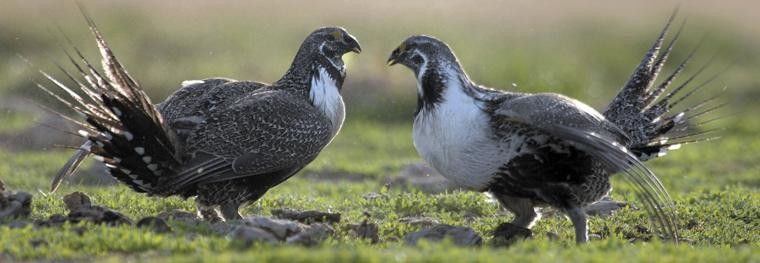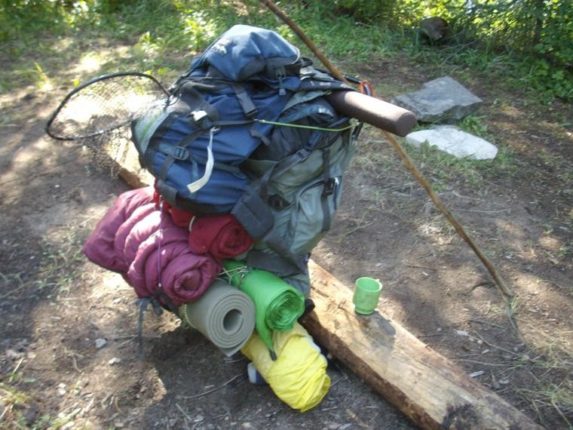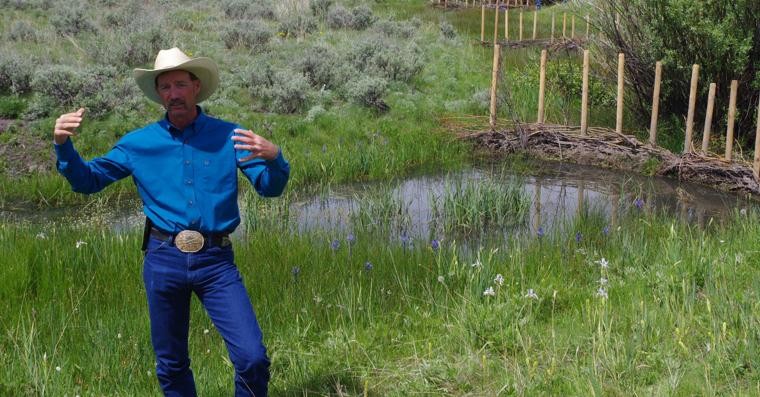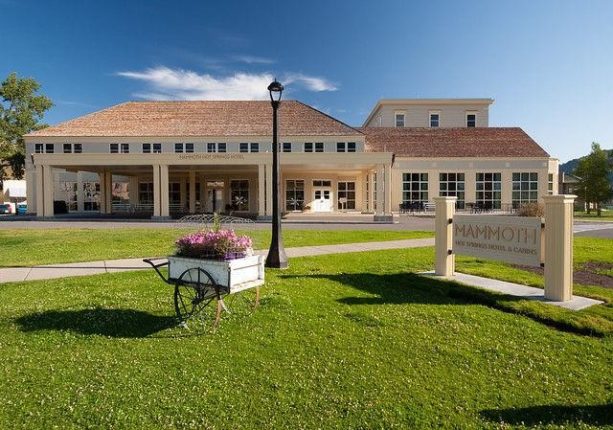Landowners and conservation professionals are excited about a new type of woody structure that mimics beaver dams. The benefits are similar — they store water, slow down runoff in streams and enhance fish and wildlife habitat.
They’re called beaver dam analogs, or BDAs for short.
Bruneau rancher Chris Black worked together with a number of conservation professionals to install some BDAs on his private land on Hurry Up Creek, a tributary of Deep Creek.
“I’ve wanted to get beaver in here for years, but it is an ephemeral stream,” Black said. “There’s enough willows to make good food for them and everything, but there isn’t enough water for them to stay.”
They’ve put in about 10 structures so far, and more are planned in the future.
“They came in and put them in very successfully,” he said. “They’re backing water up, they’re creating habitat for spotted frogs, for sage grouse, for beaver.”
In fact, when the group visited the site recently, a few people got down on their hands and knees and tried to find frogs right away. Bingo! A biologist emerges with a frog in his hand.
Conservation professionals with the Governor’s Office of Species Conservation, U.S. Fish and Wildlife Service, Idaho Fish and Game, and the Natural Resources Conservation Service are all interested in exploring the benefits of using BDAs to improve riparian habitat and store water.
The emerging technology of using natural on-site woody materials to build BDAs is building popularity in Idaho and the Intermountain West. The concept was developed initially by Utah State University and Anabranch Solutions, and it’s catching on in Idaho.
“It just benefits a whole host of wildlife species and that’s why Fish and Game is really interested in this,” said Chris Yarbrough, habitat biologist for the Idaho Department of Fish and Game. “It’s a low-cost way to get a lot of bang for your conservation buck.”
The Life on the Range crew visited two very different projects on opposite sides of Idaho to learn why BDAs were installed, how they were built, and what benefits may occur.
Experimenting with BDAs on Chris Black’s property was a natural fit, officials said, because it adds value to a number of conservation projects that have been completed in the area. Plus, there’s a healthy population of sage grouse living nearby.
That’s why the Sage Grouse Action Team was excited about the opportunity.
“We needed to figure out how to put these dollars on the ground in the best way possible and leverage what’s already being done,” said Josh Uriarte, a project manager for the Governor’s Office of Species Conservation in Boise.
“One of the things coming up is mesic meadows, and how to improve mesic habitats, working with the different partners and agencies on how to do that. We need to be strategic in that, not just putting dollars in postage stamp-type areas, but in strategic locations.
“I think it will benefit sage grouse in terms of expanding the sponge. That green line of habitat will bring in the sage grouse and have more of a grocery cart for them when they come to the store. If we provide more of a green line for them, it’ll help during late brood season.”
Hawley Creek Project near Leadore, Idaho
The Hawley Creek project is far more complex than the Hurry Up Creek project in many respects. With about 25 BDAs in place, Hawley Creek has been turned into a perennial stream.
But the objectives of the project are similar — to improve habitat for fish and wildlife and provide season-long flows in a historically ephemeral stream for endangered salmon, steelhead and resident fish.
Hawley Creek is a tributary of the Lemhi River near Leadore at an elevation of 6,000 feet.
The project has a major irrigation component for nearby ranchers who have long-time water rights on the stream. Daniel Bertram with the Governor’s Office for Species Conservation in Salmon spent several years planning the project to make sure it worked for everyone.
“There were two years of negotiations to ensure that there was no harm to the irrigators,” said Daniel Bertram, project manager for OSC in Salmon. “We need to make sure that we keep the agricultural community healthy and vibrant through these projects, and I personally don’t think there’s any reason why we can’t have both agriculture and anadromous fish thriving.”
The NRCS designed a new irrigation system that pipes irrigation water to the landowners’ property. The Lemhi Soil and Water Conservation District installed the projects to serve McFarland Land & Livestock and Leadore Land Partners.
The Lemhi Regional Land Trust secured an easement to make the irrigation projects possible.
A portion of the project crossed BLM land, so an environmental assessment was required, as well.
“The Hawley Creek BDAs are a small part of a much larger project on Hawley Creek to restore riparian habitat and improve fisheries habitat,” said Linda Price, BLM field manager in Salmon. “We thought it was a great idea.”
Ultimately, the new project configuration with an enclosed pipeline and pivot irrigation was more efficient, conserving water to restore season-long flows to Hawley Creek. The stream hadn’t held water throughout an entire season for the previous century.
“By holding this water higher in the drainage, we’re not only providing habitat for native fish and anadromous fish, but we’re also providing irrigation water later in the season when they need it as well,” Bertram said.
As Bertram worked through all the planning and permitting issues, the final step was to obtain wetlands and stream-alteration permits from the Army Corps of Engineers and the Idaho Department of Water Resources.
They put in the BDAs with help from the Salmon Youth Employment Program. Eleven more will be installed this year.
“It’s been a really neat project. The kids really like it,” said Max Lohmeyer, project coordinator for the Salmon Youth Employment Program. “It’s a lot like building fence, but it’s not building fence. They get to get in the creek and get wet.”
In both project locations, they used hydraulic post-pounders to install the vertical posts for the BDAs.
“It’s unreal how much of a difference that makes,” Yarbrough said. “We did a couple by hand last year and that took forever! These posts, it takes maybe five seconds, 10 seconds, that’s been a huge difference-maker, and now that we have that, are you kidding me? This is a piece of cake now.”
And then they used local woody materials such as willows for the horizontal cross-section to slow down and hold back the water flow.
They put in the first five BDAs on Hawley Creek with local volunteers, including school children from Leadore and officials from Trout Unlimited.
In the following year, the Salmon Youth Employment Program put in another 15 structures.
“At first, they were like, why are you building beaver dams? Once they saw the results, they didn’t want to go build more fence, they wanted to build more beaver dams,” Lohmeyer said.
The biggest challenge was bringing in willow branches from other locations. Hawley Creek had dried up for years and only had some large juniper trees growing next to it. “I’d have to say that harvesting willows was one of the most challenging projects we’ve had,” Lohmeyer said. “Sometimes we’ve been bringing in willows 20, 30, 40 miles from the project site.”
After installing the branches and willows against the posts, the structures tend to seal up on their own. Bertram is pleased with the results so far. He is closely tracking results.
“I couldn’t be happier, to be honest,” Bertram said. “Hawley Creek hasn’t dried up, and it’s pretty neat to see where it’s come, and see the benefits for the private landowners, and also to the ecosystem.”
By restoring season-long flows to Hawley Creek, that should provide improved, over-wintering habitat for fish. As the riparian area converts more to a wet meadow, there may be benefits for sage grouse as well.
“By slowing this water down, spreading it out, you can just see the response from the vegetation, the grass growing up, I can hear the grasshoppers in the background, passerines have just exploded, all of the wildlife species and insects have just exploded,” Bertram said. “And we’re already seeing brood-rearing sage grouse coming into this area and utilizing it in the short period we’ve been here. It’s been a huge success story for them, and I’m excited to see how the leks respond over time.”
Chris Black likes the results on Hurry Back Creek as well.
“These meadows are like a sponge,” Black said. “They take that water and they hold it, and release it slowly into the system. So we don’t get that big rush in the spring, when the springs are active, they run hard and then just dry up. Then you just have a dry meadow. With water being held back in the system, it releases slowly, and that benefits downstream users, too, so it’s a benefit for everything.”
Black brings his cattle into the Toy Valley area in the fall, when the valley is chock full of tall grass for the cattle to eat.
“This is going to help my cows. All of this water, secondary effects, more grass, but holistically, what helps my cows will help all other species, too,” Black said.
Officials have appreciated the opportunity to partner with willing landowners to try out a new conservation practice on private land.
“The opportunity we have with private landowners is really to lean into some risk, a little bit more than the federal land management agencies, where they can demonstrate an opportunity with a conservation practice, that we may not be able to do on public land,” said Jason Pyron, Idaho Sage Grouse Coordinator for the U.S. Fish and Wildlife Service.
“So Chris is a progressive landowner, and we appreciate his willingness to provide an opportunity to learn, a new conservation practice out here, and recognizing that we are going to have some failures, we can use this as a demonstration site, and then allow us to implement this on public land.”
Easy access from Mud Flat Road, the Owyhee Backcountry Byway, will allow ranchers and conservation professionals to host tours of the Hurry Back Creek BDA project.
“This will be a demonstration site for a lot of state, federal and nonprofit partners,” Pyron said. “Conservation is local. So you have to demonstrate these in different kinds of landscapes across the state.”
Bertram also has been hosting tours on the Hawley Creek project to share early results. And he’s doing in-depth monitoring to track vegetation and water trends.
“We’ve done a tremendous amount of monitoring,” he said. “Aerial monitoring with high-resolution videography, where we can show the change in vegetation community, and then they have equipment to show ground water depth so we can see what’s happening with the ground water.”
Ultimately, Black likes the strength of multiple partners working together to improve wildlife habitat.
“With all of us coming together, we can create great leaps in conservation, with money and time, and it all comes together,” Black said “Everyone’s working together, and it becomes a great story for how we can manage these lands in the future.”
Steve Stuebner is the writer and producer of Life on the Range, a public education project sponsored by the Idaho Rangeland Resources Commission (idrange.org).






